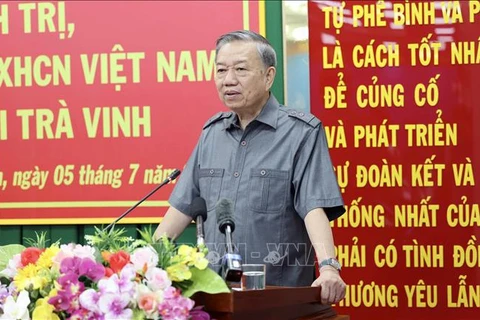
Hanoi (VNA) – Vietnam has made significant achievements over the past nearly 40 years of Doi Moi (Reform), with hunger eradication and poverty reduction being a key and consistent policy of the Party and State.
As the first and only country in Asia to implement a comprehensive, inclusive, and sustainable multidimensional poverty reduction programme, Vietnam’s efforts have been internationally hailed as a “revolution” in poverty alleviation, driving changes across the country, even in its most remote rural regions.
Strategic tasks in sustainable development
The Party and Government have consistently underscored that comprehensive poverty reduction and improving living standards are urgent priorities and a key and strategic task to ensure the country’s rapid and sustainable development.
Acknowledging that quality of life extends beyond income alone, the Government in 2015 introduced a multidimensional poverty index (MPI) for the 2016-2020 period, marking a significant shift from income-based poverty measurement to a more holistic approach.
Under this new standard, poverty is defined with higher criteria, based on indicators measuring deficiencies in access to basic social services such as health care, education, housing, clean water and sanitation, and information. This approach has positioned Vietnam as a leader in the Asia-Pacific in adopting multidimensional poverty measurement to address the issue across all aspects.
The use of the national poverty standard is not only crucial for developing relevant policies and programmes and monitoring efforts in Vietnam but also helps the country track its progress toward achieving the United Nations Sustainable Development Goals (SDGs).
Poverty reduction has been established as one of the three national target programmes, along with others on new-style rural area building and socio-economic development in mountainous and ethnic minority-inhabited areas. For the 2021-2025 period, the country aims to reduce the multidimensional poverty rate by 1-1.5% annually, with the poverty rate among ethnic minorities to drop by over 3% per year.
Additionally, specific poverty reduction policies, prioritising vulnerable groups and disadvantaged and ethnic minority-inhabited areas, have been put in place, providing targeted support to address the needs of these populations.
To implement these programmes, the Government has issued an action plan and established the Central Steering Committee for the National Target Programme on Sustainable Poverty Reduction. It has also introduced a legal framework to guide efforts in sustainable poverty reduction, which includes criteria for identifying poor and near-poor households, and impoverished districts, communes, and hamlets.
Localities and all-level Vietnam Fatherland Front Committees, and other organations have also joined such efforts.
No one left behind
Vietnam is one of the first 30 countries in the world and the first in Asia to adopt the MPI in an effort to ensure a minimum living standard and address gaps in the access to basic social services, aiming for comprehensive and inclusive support for the poor and those living in impoverished areas. It is also expected to help improve the quality of both their material and spiritual life.
Each year, the country allocates substantial resources to the work, with the funding mainly from the central budget, different economic sectors, and contributions from the "For the Poor" fund managed by all-level VFF Committees.
As a result, Vietnam’s per capita income has risen to about 4,650 USD from only 185 USD in 1993. Last year, its multidimensional poverty rate decreased by 1.1% to 2.93%. Additionally, 10 extremely disadvantaged coastal and island communes successfully got rid of poverty.
Rural economic and social infrastructure has seen remarkable improvements which give a facelift to the areas and contribute to promoting production and raising living standards there.
Once among the poorest countries in the world, Vietnam has over the past few decades transformed into one of the fastest-growing economies. From 1989 to 2023, its per capita GDP recorded a 40-fold increase. In two decades, more than 40 million people have been lifted out of poverty. Vietnam achieved the United Nations Millennium Development Goal on poverty reduction ahead of schedule, winning recognition from the international community as a global success story in poverty alleviation.
According to the Global Multidimensional Poverty Index report released announced on July 15, 2023, by the UN Development Programme (UNDP) and the Oxford Poverty and Human Development Initiative, Vietnam is one of the 25 countries that have halved their MPI within 15 years.
In April 2022, the World Bank, in its report "From the Last Mile to the Next Mile: Vietnam Poverty and Equity Assessment 2022", noted that the amount of progress that Vietnam has achieved in less than half a century since the war ended in 1975 has been nearly without parallel./.






















